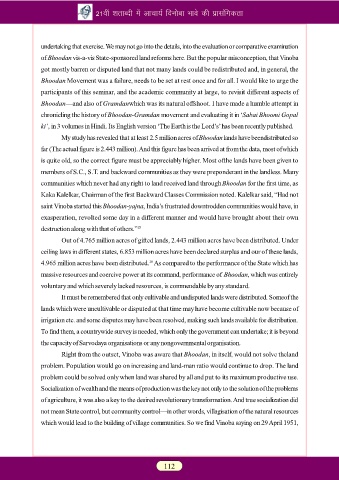Page 112 - Acharya Vinoba Bhave in 21st Century ISBN
P. 112
21oha “krkCnh esa vkpk;Z fouksck Hkkos dh izklafxdrk
undertaking that exercise. We may not go into the details, into the evaluation or comparative examination
of Bhoodan vis-a-vis State-sponsored land reforms here. But the popular misconception, that Vinoba
got mostly barren or disputed land that not many lands could be redistributed and, in general, the
Bhoodan Movement was a failure, needs to be set at rest once and for all. I would like to urge the
participants of this seminar, and the academic community at large, to revisit different aspects of
Bhoodan—and also of Gramdanwhich was its natural offshoot. I have made a humble attempt in
chronicling the history of Bhoodan-Gramdan movement and evaluating it in ‘Sabai Bhoomi Gopal
ki’, in 3 volumes in Hindi. Its English version ‘The Earth is the Lord’s’ has been recently published.
My study has revealed that at least 2.5 million acres of Bhoodan lands have beendistributed so
far (The actual figure is 2.443 million). And this figure has been arrived at from the data, most of which
is quite old, so the correct figure must be appreciably higher. Most ofthe lands have been given to
members of S.C., S.T. and backward communities as they were preponderant in the landless. Many
communities which never had any right to land received land through Bhoodan for the first time, as
Kaka Kalelkar, Chairman of the first Backward Classes Commission noted. Kalelkar said, “Had not
saint Vinoba started this Bhoodan-yajna, India’s frustrated downtrodden communities would have, in
exasperation, revolted some day in a different manner and would have brought about their own
destruction along with that of others.” 15
Out of 4.765 million acres of gifted lands, 2.443 million acres have been distributed. Under
ceiling laws in different states, 6.853 million acres have been declared surplus and our of these lands,
16
4.965 million acres have been distributed. As compared to the performance of the State which has
massive resources and coercive power at its command, performance of Bhoodan, which was entirely
voluntary and which severely lacked resources, is commendable by any standard.
It must be remembered that only cultivable and undisputed lands were distributed. Someof the
lands which were uncultivable or disputed at that time may have become cultivable now because of
irrigation etc. and some disputes may have been resolved, making such lands available for distribution.
To find them, a countrywide survey is needed, which only the government can undertake; it is beyond
the capacity of Sarvodaya organisations or any nongovernmental organisation.
Right from the outset, Vinoba was aware that Bhoodan, in itself, would not solve theland
problem. Population would go on increasing and land-man ratio would continue to drop. The land
problem could be solved only when land was shared by all and put to its maximum productive use.
Socialization of wealth and the means of production was the key not only to the solution of the problems
of agriculture, it was also a key to the desired revolutionary transformation. And true socialization did
not mean State control, but community control—in other words, villagisation of the natural resources
which would lead to the building of village communities. So we find Vinoba saying on 29 April 1951,
112

